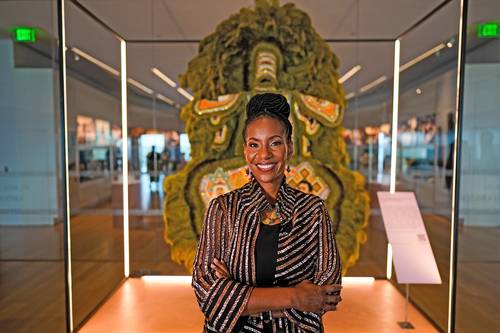Tonya Matthews, president and director of the International African American Museum, said the only thing you need to bring to this museum is curiosity, we will do the rest
.Ap’s photo
Charleston. The African American International Museum, which opens to the public today in South Carolina, will allow visitors to delve into the origins and pilgrimage of enslaved Africans and their descendants, whose arrival in the Western Hemisphere began at the docks of the coast lowcountry (the lowlands).
Overlooking the old wharf in Charleston, where nearly half of the enslaved population first entered North America, the 14,000-square-foot museum houses exhibits and pieces that explore how work, perseverance, resilience, and cultures of African Americans shaped the Carolinas, the nation, and the world.
It also includes a genealogical research center to help families trace the journey of their ancestors from the point of arrival to these lands.
The inauguration comes at a time when the United States is questioning the very idea that the survival of the black population, despite slavery, the apartheid racial and economic oppression, is the quintessential American story.
Museum officials said its existence is not a rebuttal to current attempts to suppress history, but rather an invitation to dialogue and discovery.
Show me a brave space, show me an open space, show me a space that meets me where I am and then takes me where I asked to go.
says Dr. Tonya Matthews, the museum’s president and CEO. I think that’s the superpower of museums. The only thing you need to bring to this museum is your curiosity and we will do the rest.
The $120 million museum features nine galleries containing nearly a dozen interactive exhibits of more than 150 historical objects and 30 works of art. One of the museum’s exhibits will rotate two to three times a year.
Upon entering the venue, eight large screens repeatedly play images of a diaspora journey spanning centuries, from the cultural roots on the African continent and the horrors of the Middle Passage to the regional and international legacies that arose from the dispersal and migration of the Africans through new territories.
A unique feature of the museum is its gallery dedicated to the history and culture of the Gullah Geechee people. Their isolation on rice, indigo, and cotton plantations on coastal South Carolina, Georgia, and northern Florida helped them maintain ties to West African cultural traditions and creole language. A house of praise
chapel-sized multimedia in the gallery highlights the expressions of faith of the gullah geechee and shows how those expressions are imprinted in gospel music.
The truth sets us free: free to understand, free to respect, and free to appreciate the full spectrum of our shared history.
said former Charleston mayor Joseph Riley Jr, who is credited with coming up with the idea for the museum in the city.
Delay of almost two decades in its construction
Planning for the museum dates back to 2000, when Riley called for its creation in the City Government Report. Many more years passed, with fundraising setbacks and changes in museum leadership before construction began in 2019.
Gadsden’s Wharf, a 100-square-foot waterfront site where an estimated half of the African slaves brought to what is now the United States in the late 18th and early 19th centuries walked, sets the standard for how people experience the museum. The pier was built by Christopher Gadsden, a figure in the American Revolutionary War.
The land is now part of an intentionally designed ancestral garden. Black granite walls were erected on the site of a former warehouse, a space where hunched, enslaved human beings perished waiting to be transported to the slave market. The walls are adorned with lines from Maya Angelou’s poem, And Still I Rise (And still I get up).
The main structure of the museum did not touch the hallowed grounds on which it stands. Instead, it is raised above the pier by 18 cylindrical columns. Beneath the structure is a shallow fountain that pays tribute to the men, women and children whose bodies were inhumanely chained in the bellies of the transatlantic slave trade ships.
To discourage visitors from walking on the raised outlines of the chained bodies, a footpath was created through the center of the pier memorial site.
There is something incredibly significant about taking back a space that was once the landing point, the start of a horrifying journey for captured Africans.
said Malika Pryor, the museum’s director of learning and education.
Walter Hood, founder and creative director of Oakland, California-based Hood Design Studios, designed the landscape for the museum grounds. The designs are inspired by tours of the lowcountry and its old plantations, he explained. The lush grounds, winding pathways, and seating areas are meant to be an ethnobotanical garden, compelling visitors to see how the botany of enslaved Africans and their descendants helped shape what still exists today in both Carolinas. .
The opening of the Charleston museum adds to a growing array of institutions dedicated to teaching an accurate history of the black experience in America. Many will have heard of the Smithsonian’s National Museum of African American History and Culture in the nation’s capital, which opened in 2016.
Lesser-known Afrocentric museums and exhibits exist in almost every region of the country. In Montgomery, Alabama, The Heritage Museum: From Slavery to Mass Incarceration and the accompanying National Monument for Peace and Justice highlight slavery, Jim Crow, and the history of lynching in America.
Pryor, former educational director of the Charles H. Wright Museum of African American History in Detroit, said these types of venues focus on parts of American history that haven’t been discussed or covered enough.
This is an incredibly expansive story. There is room for 25 more museums that would have the opportunity to bring a fresh curatorial perspective to this conversation.

[…] Link to the Observatorial here […]